To soften your coarse beard hair, start by washing it 2-3 times weekly with sulfate-free beard shampoo and warm water. Apply natural oils like jojoba or argan daily, working 3-4 drops from roots to tips. Use a boar bristle brush to distribute oils and exfoliate the skin beneath. Incorporate a weekly deep conditioning treatment, and maintain proper hydration by drinking plenty of water. Regular trimming every 2-4 weeks prevents split ends, while a balanced diet rich in vitamins supports healthy growth. Keep your beard protected from harsh weather, and establish a consistent grooming routine with quality tools. The key steps outlined above are just the beginning of your journey toward a softer, more manageable beard.
Highlights
- Wash your beard 1-3 times weekly with sulfate-free beard shampoo to maintain natural oils while keeping it clean.
- Apply natural oils like jojoba or argan to your clean, dry beard daily for optimal softness and hydration.
- Use a boar bristle brush to distribute natural oils evenly throughout your beard and exfoliate the skin beneath.
- Incorporate a quality beard conditioner after washing to improve manageability and reduce coarseness.
- Stay hydrated by drinking eight glasses of water daily and eating nutrient-rich foods to promote healthier beard growth.
Daily Beard Washing Routine
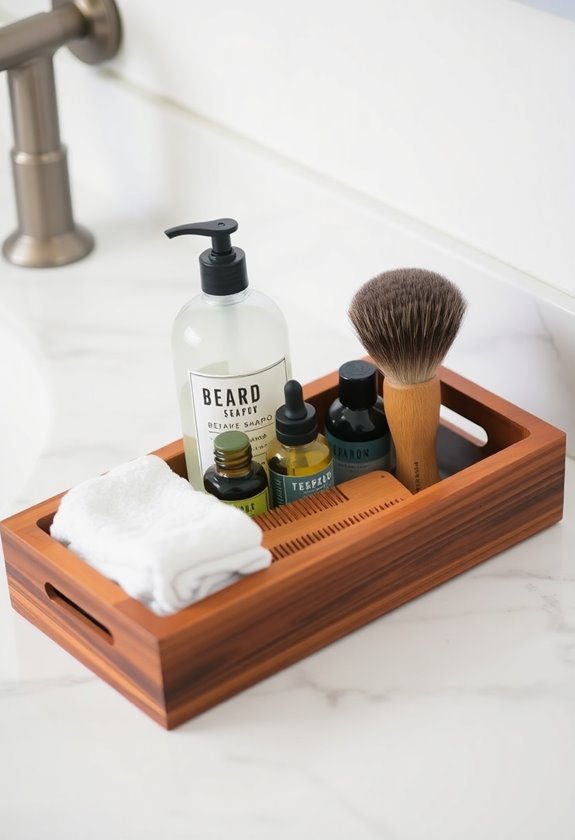
Three key factors determine how often you should wash your beard: your hair type, environment, and daily activities. While you'll need to rinse your beard daily with warm water, limit actual washing to 1-3 times per week to maintain natural oils and prevent dryness.
When washing, you'll want to use sulfate-free beard shampoo that's specifically formulated for facial hair, followed by a quality beard conditioner to keep your hair soft and manageable. For best results, exfoliate the skin beneath your beard once or twice weekly to remove dead skin cells and promote healthy growth. Using a boar's hair brush in circular motions helps remove dandruff and distributes natural oils throughout your beard. Consider adding premium beard oil to your routine for extra nourishment and softness. If you're particularly active or work in a dusty environment, you might need to wash more frequently, but always balance cleansing with moisturizing to protect your beard's natural oils.
Moisturize With Natural Beard Oils

Beyond regular washing, proper moisturizing with natural beard oils can transform your coarse facial hair into a soft, manageable mane. To get the best results, you'll want to apply oils like jojoba and argan to your clean, dry beard while massaging from roots to tips. The combination of Maracuja and Shea oils provides exceptional moisture retention for even the most unruly beards.
For daily application:
- Warm 3-4 drops of oil between your palms before working it through your beard
- Focus on distributing the oil evenly, reaching the skin underneath
- Use a beard comb to guarantee thorough coverage and proper styling
When selecting your beard oil, opt for products containing natural ingredients like castor oil and sweet almond oil, while avoiding synthetic additives that might dry out your facial hair. You'll find that consistent application helps prevent beard dandruff and promotes healthier growth over time.
Choose Quality Grooming Tools
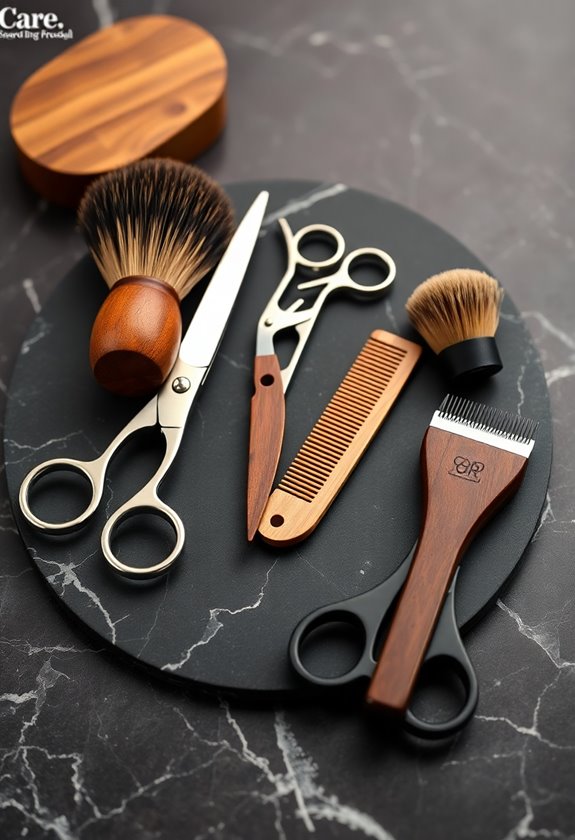
Every beard grooming journey begins with selecting the right tools for your facial hair type. You'll need both a quality comb and brush to effectively manage and soften coarse beard hair. A premium birchwood boar bristle brush is particularly effective for smoothing and styling your beard.
For daily grooming, invest in a wide-toothed pearwood or amoora wood comb that'll gently detangle without causing breakage. Consider adding a boar bristle brush to your routine, as it's exceptional at distributing natural oils throughout your beard. For sensitive skin, you might prefer a softer horsehair brush that'll provide gentle exfoliation while training your facial hair. When choosing tools, look for:
- Wooden handles for better grip and control
- Wide-tooth spacing for detangling thick hair
- Natural bristles for oil distribution
- Portable options for on-the-go maintenance
- Durable materials that won't snag or damage hair
Regular Trimming and Maintenance
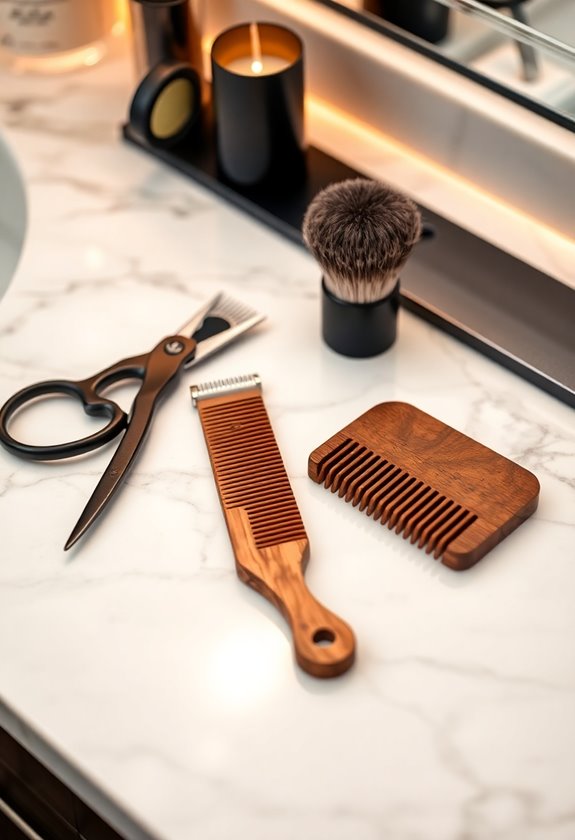
Regular maintenance and trimming are essential steps in transforming coarse beard hair into a softer, more manageable growth. You'll need to adjust your trimming schedule based on your beard length: weekly for short beards, every 2-4 weeks for medium length, and every 6-8 weeks for longer styles. Natural bristle brushes help prevent static and irritation when grooming your facial hair.
Start by combing through your beard to identify uneven areas and stray hairs that need attention. When trimming, make small, conservative cuts using a quality beard trimmer or scissors, and don't forget to maintain your neckline for a clean appearance. While you're at it, establish a regular maintenance routine that includes washing your beard 1-3 times weekly, applying beard oil daily, and using a boar bristle brush to distribute natural oils throughout your facial hair.
Deep Conditioning Treatment Schedule
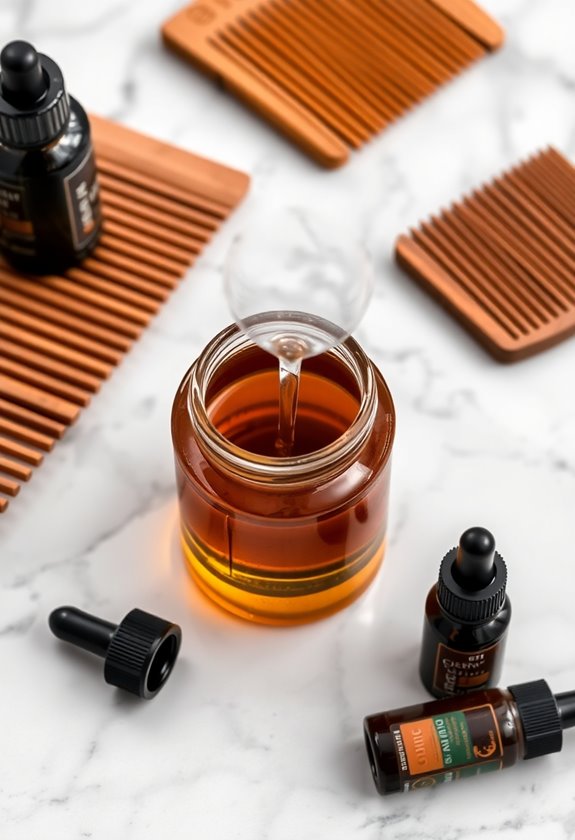
A proper deep conditioning schedule will transform your coarse beard into a softer, more manageable mane. For best results, you'll want to deep condition once or twice weekly if your beard is particularly dry or coarse, while those with normal beards can stick to a weekly routine. Consistent care and attention will ensure your beard reaches its maximum potential.
Start with a clean, wet beard and apply twice the amount of conditioner you’d normally use, working it thoroughly through your facial hair. Choose a high-quality beard conditioner containing nourishing ingredients like argan, jojoba, or coconut oil, and let it sit for 3-5 minutes before rinsing. To enhance the treatment’s effectiveness, wrap your beard in a warm towel while the conditioner penetrates, and follow up with a leave-in conditioner and beard oil for lasting softness. Start your morning skincare routine by gently patting your beard dry with a soft towel. As a final step, comb through your beard to distribute the conditioning treatments evenly. With regular use, this simple yet effective conditioning routine will keep your beard looking and feeling healthy and hydrated.
Protect Against Environmental Factors
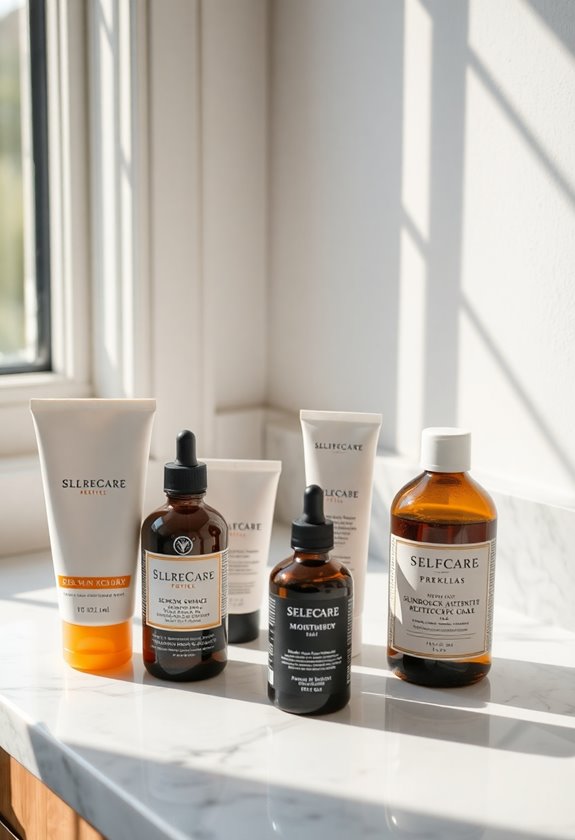
While your beard may look great indoors, environmental factors can quickly turn soft strands into coarse, brittle hair. To protect your beard from harsh weather conditions, you'll need to create a defensive strategy against environmental stressors.
Start by shielding your beard from extreme temperatures and direct sunlight, which can strip away natural oils and cause UV damage. When you're outdoors, wear a hat or scarf to protect your facial hair from wind and cold. You'll want to minimize exposure to harmful chemicals by choosing sulfate-free beard washes and natural, plant-based grooming products. Apply a protective layer of beard oil rich in jojoba or argan oil daily, and don't forget to stay hydrated by drinking plenty of water to maintain healthy hair from the inside out.
Proper Beard Brushing Techniques
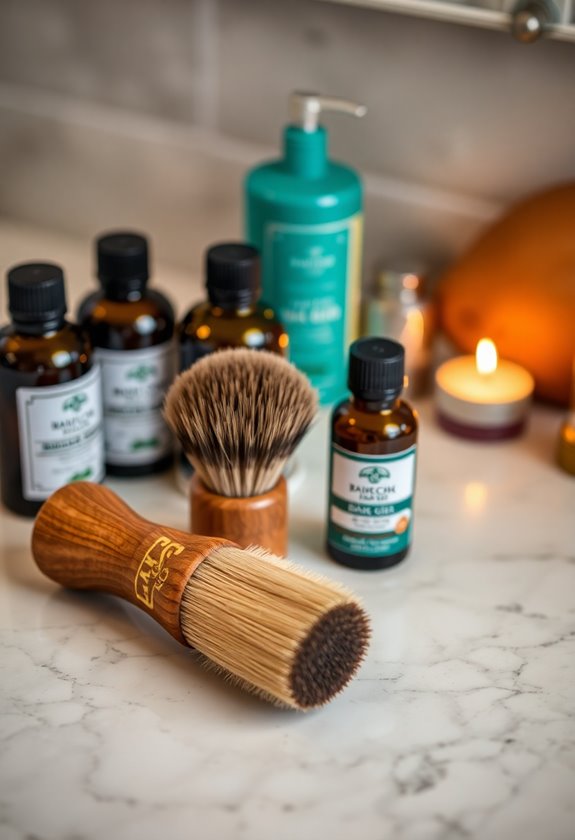
Now that your beard is protected from environmental damage, mastering proper brushing techniques will help maintain its softness and manageability. Start by selecting a brush with natural boar bristles and a wooden handle, which will help distribute oils and exfoliate the skin beneath your beard.
Begin your brushing routine by working upward and outward to detangle and align the hair strands, being gentle with any knots you encounter. Next, brush downward in the direction of hair growth while paying special attention to your mustache area, directing shorter hairs downward and longer ones outward. For the most effective results, you'll want to brush slowly and methodically, working in layers if you have a longer beard, and finish by applying beard oil or balm to lock in moisture.
Natural Beard Balm Application
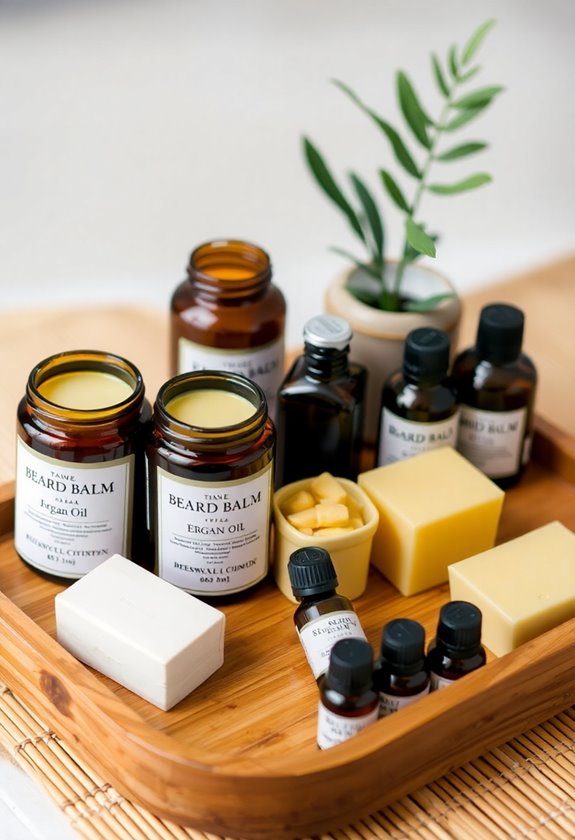
Beard balm serves as your secret weapon for achieving a softer, more manageable beard. You'll want to apply it right after your shower when your beard is slightly damp and your pores are open for maximum absorption.
For the best application results, follow these essential steps:
- Scoop out a pea-sized amount of balm and warm it between your palms until it melts
- Work the balm from your beard's roots to the tips, massaging it into the skin beneath
- Use a beard comb to distribute the product evenly throughout your facial hair
- Style your beard with your fingers or comb while the balm sets
Remember to choose balms with natural sealants like beeswax, and don't overdo the amount as this can leave your beard looking greasy and weighed down.
Healthy Hydration and Nutrition
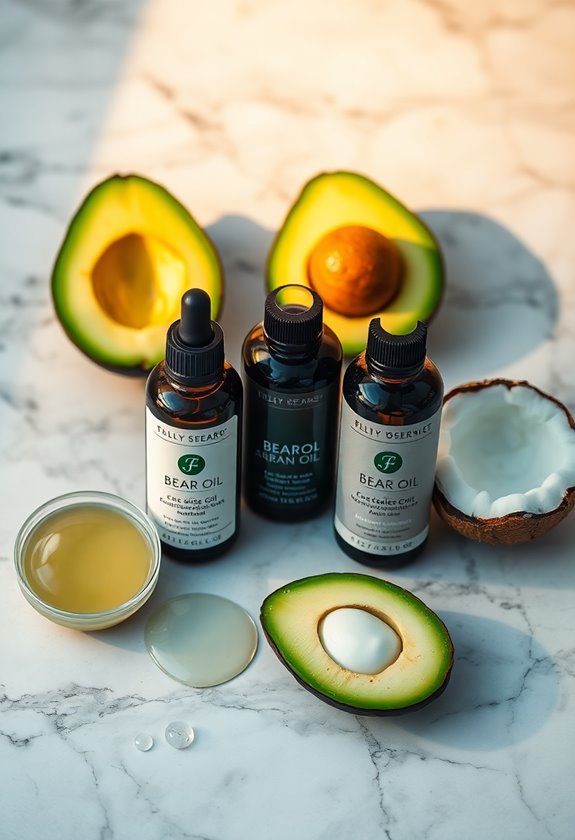
Proper hydration and nutrition form the foundation of a healthy, softer beard. You'll need to drink at least 8 glasses of water daily while incorporating water-rich foods like cucumbers and watermelon into your diet for ideal hydration.
To support your beard's health from the inside out, focus on foods rich in vitamins and minerals that promote hair growth while limiting dehydrating substances like coffee and alcohol. Include natural oils such as jojoba and argan in your beard care routine to lock in moisture, and consider using a humidifier in dry environments to maintain proper hydration levels. When you're well-hydrated, you'll prevent common issues like brittle hair, flaky skin, and irritation that can make your beard feel coarse and uncomfortable.
Exfoliate Your Facial Skin
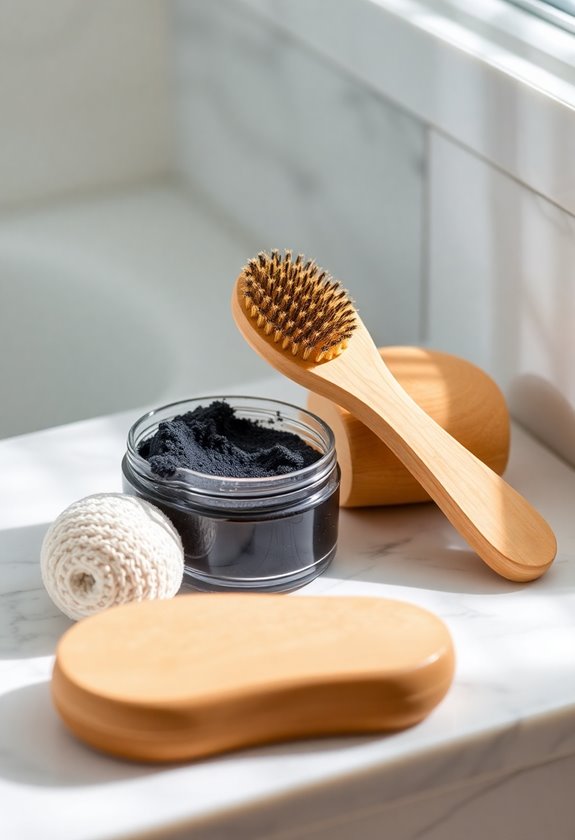
Along with maintaining internal hydration, keeping your facial skin clean and clear directly impacts beard softness. You'll need to exfoliate 1-2 times weekly using either mechanical or chemical methods to remove dead skin cells and excess oil that can make your beard coarse and unmanageable.
- For sensitive or dry skin, use chemical exfoliants like AHAs instead of mechanical scrubs
- Apply gentle, circular motions with a soft-bristled brush or clean toothbrush under your beard
- Consider using the Braun FaceSpa with its specialized exfoliation attachments for precise control
- Follow exfoliation with a moisturizing beard conditioner to lock in hydration
Remember to be gentle during the process, as over-exfoliation can irritate your skin and affect beard growth, while proper exfoliation helps your beard absorb conditioning products more effectively. Using hydrating face masks weekly can provide additional moisture and nourishment to both your facial skin and beard hair.
Frequently Asked Questions
Can Certain Medications Affect Beard Texture and Softness?
Yes, medications can greatly affect your beard's texture and softness. Chemotherapy drugs often cause hair to become coarser when it regrows, while certain antidepressants and steroids may alter your beard's natural texture through hormonal changes. You'll notice that medications affecting your hormone levels, particularly those impacting testosterone or thyroid function, can make your beard feel rougher or more brittle than usual.
How Long Does It Take for a Beard to Adjust to New Products?
Your beard typically takes 1-3 weeks to adjust to new grooming products during the initial phase. You'll notice changes in texture and comfort as your facial hair adapts to the new ingredients. During this adjustment period, you might experience some itching or dryness, but don't give up – it's completely normal. For best results, you'll want to maintain consistent product use throughout the full adaptation period of 10-12 months.
Will Dyeing My Beard Make It More Coarse and Brittle?
Yes, dyeing your beard will likely make it more coarse and brittle because the chemical components strip away natural oils and proteins. Traditional dyes containing ammonia, hydrogen peroxide, and PPD can greatly damage your beard's structure, leading to increased dryness and roughness. You'll need to counter these effects with intensive moisturizing through beard oils and conditioners, or consider gentler alternatives like henna-based dyes and gradual color-changing products.
Does Facial Hair Texture Change With Age or Hormonal Fluctuations?
Yes, your facial hair texture definitely changes with both age and hormonal shifts throughout your life. As you get older, you'll notice your beard might become coarser due to shrinking follicles and decreased sebum production. During significant hormonal changes, particularly fluctuations in testosterone levels, you'll likely experience variations in both hair thickness and texture, which can make your facial hair feel either softer or more bristly.
Can Vitamin Supplements Improve Beard Softness and Manageability?
Yes, vitamin supplements can greatly improve your beard's softness and manageability when taken consistently. You'll see the best results by combining biotin, vitamins A, C, D, and E with essential minerals. While it takes 3-6 months to notice visible changes, these supplements support sebum production and strengthen hair follicles from within, making your beard naturally softer and easier to manage.




